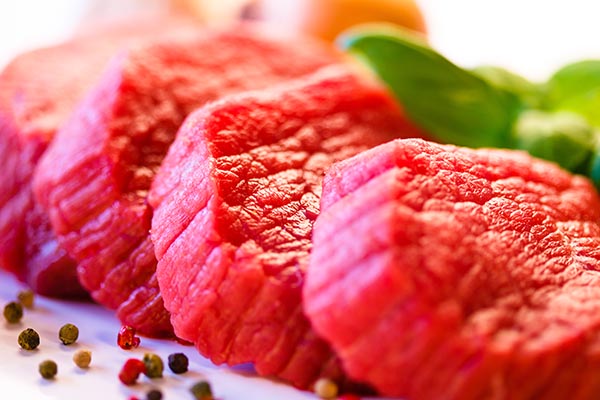Russian beef market – key trends in 2020
The Russian beef market is characterized by:
• a slight increase in beef production in 2018–2020.
In 2017, the production of beef in the Russian Federation in farms of all categories reached the minimum values ??for the entire period considered in the study (since 1990) and amounted to 1,569.3 thousand tons in carcass weight. In 2018, 2019 and 2020 recovery of indicators was noted. In 2020, production increased to 1,630.7 thousand tons.

In recent years, production has been recovering at the expense of the industrial sector (beef from livestock raised by agricultural organizations and peasant farms). Here, the indicators have been steadily increasing over the past 9 years. In 2011, the industrial production of beef in the Russian Federation amounted to only 600.6 thousand tons, by 2020 it increased to 786.3 thousand tons (by 30.9%).
The growth in beef production in the industrial sector is taking place in the context of the intensive development of the beef cattle breeding industry in the Russian Federation. The number of beef cattle in agricultural organizations by the beginning of 2020 reached 1,013.9 thousand heads against 508.2 thousand heads by the beginning of 2012. Beef cattle, as of early 2020, accounted for 12.5% ??of the herd population. At the same time, even 8 years before that, the figure was 5.5%.
On the other hand, in households, beef production is declining. The trend has been stable for 10 years. During this period, the indicators decreased by 20.7% to 844.5 thousand tons.
In the medium term, the trend towards an increase in beef production in the industrial sector and a decrease in households is expected to continue. Against this background, the total production volume will be at relatively stable levels, its slight growth is possible.
In general, the production of beef in the Russian Federation, if we consider all categories of farms, decreased by 4.7% over 10 years, by 14.1% over 20 years, and by 62.3% over 30 years.
• Drop in imports of beef and offal.
In 2013, the total volume of imports of chilled, frozen beef and offal to the Russian Federation amounted to 831.8 thousand tons. In 2014, amid a weakening of the national currency and the suspension of imports of beef from a number of countries, supplies decreased to 772.2 thousand tons, in 2015 - they fell to 545.4 thousand tons. In 2016–2020 the reduction in the volume of imports continued. At the end of 2020, imports of beef and offal amounted to only 333.3 thousand tons. Of this volume, 61.9 thousand tons fell on chilled beef, 199.5 thousand tons - frozen beef, 0.9 thousand tons - chilled beef offal, 71.9 thousand tons - frozen beef offal.
• Expansion of export volumes of beef and offal.
In 2020, the total volume of exports of beef and beef offal amounted to 20.1 thousand tons, amounting to USD 95.5 million. For comparison, in 2019 supplies were only 9.5 thousand tons, 5 years ago – 2.9 thousand tons. Including chilled beef accounted for 1.3 thousand tons, frozen beef – 14.8 thousand tons, beef offal – 4.0 thousand tons.
The key buyer of chilled beef from Russia is Saudi Arabia (more than 70% of volumes), frozen beef - China (more than 50% of supplies), Vietnam, Belarus, Kazakhstan, Saudi Arabia and Hong Kong, offal - Ghana (at 50% of supplies), Hong Kong , Ukraine, China and Vietnam.
• Relatively low level of regional concentration of production.
TOP-5 regions account for only 25% of the total beef production in the country, TOP-10 – 40.7%, TOP-20 – 61.4%. For comparison: TOP-5 pork-producing regions provide 42.5% of all volumes. TOP-10 accounts for 55.9%, TOP-20 – 72.4%.
• Reduced market size and consumption.
The volume of the Russian beef market in 2020 decreased to the lowest for the entire period considered in the study and amounted to 1,943.9 thousand tons. Per capita consumption fell to 13.2 kg. Note that the peak of the market volume and consumption fell on 2008 - the indicators were 2,740.9 thousand tons and 19.2 kg per capita, respectively.
As for consumption by regions of the Russian Federation, in 2020 there were 29 regions where the volume of production exceeds the volume of consumption and 53 regions where production is lower than the volume of consumption.
• An increase in the level of self-sufficiency.
The self-sufficiency of Russia in beef (the ratio of production to consumption) at the end of 2020 amounted to 83.9%. Five years before that (2015) it was at 74.9%, ten years before (2010) it was 66.3%. The growth in self-sufficiency is associated with a drop in imports.
• Rising prices for beef in Russia.
2020 is characterized by strengthening prices for livestock and beef in Russia. In addition, the cost of imported beef into the country increased (by almost 3% in dollar terms and by 15% in ruble terms). The rise in prices was facilitated by the strengthening of prices for feed, as well as the prevailing price conjuncture on the world market.
Source: Meatinfo